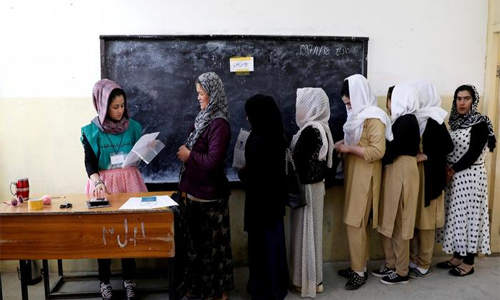After the Trump administration in the United States in January 2017, president Trump appointed Zalmay Khalilzad as U.S. special envoy to Afghanistan. His job was to bring the Afghan government and the Taliban to a reconciliation. When Khalilzad took his new assignment in September 2018, he told diplomatic colleagues that he probably had six to twelve months to produce a breakthrough for the president.
For the US, there are two key topics for negotiating with the Taliban: ensuring that renewed 9/11- style attacks cannot emanate from Afghan territory and complete withdrawal of foreign troops from Afghanistan (The US currently has 14,000 soldiers in Afghanistan. Additionally, there are some 8,000 troops from 38 NATO and non-NATO countries) which has always been the Taliban’s main demand.
Taliban are more concerned about the withdrawal of foreign troops from the country, and after the complete withdrawal, “they are ready to welcome US engineers, doctors and others if they want to come back for reconstruction of Afghanistan.” Said by Sher Muhammad Abbas Stanakzai; former head of the Taliban office in Doha.
In the beginning, Khalilzad thought that negotiating with the Taliban will be an easy task therefore, he started negotiating with the Taliban without involving Afghan government. First few meetings were successful and Khalilzad was very optimistic about peace deal with the Taliban. The US and the Taliban have largely agreed on a key demand of Washington: that the Taliban should not allow Afghanistan to be used by armed groups. But a major sticking point remains the refusal of the Taliban to negotiate with current Afghan government.
But when Taliban refused to join the current system, they made it clear that they would not simply ‘join’ or be ‘integrated’ into the current system and lay down their arms, as this would be surrender for them, and they instead demand ‘reform’, including a new constitution drafted by “Afghan (religious) scholars and intellectuals.”
After this demand by Taliban, reaction came from Afghan government and majority of the Afghan population, they were unwilling to surrender the democratic and human rights, including women’s and minorities rights that are enshrined in the current constitution.
Afghan President Muhammad Ashraf Ghani publicly said: “Afghans do not accept an interim government-not today, not tomorrow, not in a hundred years.” There were indications of widespread fears in the Afghan public that US-Taliban talks may be a withdrawal- only “exit strategy” for the US, rather than a peace agreement.
After the punitive reaction from Afghan government and people, the US said it would agree to the withdrawal it’s “combat troops” from Afghanistan “only in return for the Taliban’s entering talks with the Afghan government and agreeing to a lasting cease-fire” Khalilzad stressed elsewhere that all talks would take place in accordance with the principle that “nothing is agreed until everything is agreed.”
What was missing in the Khalilzad mission?
• Considering the current Afghan government underdog at the current peace talks with the Taliban
• Not including Afghan Government at the peace negotiation.
• Neglecting Pakistan’s rule in the peace process with the Taliban.
What is Pakistan’s Stand on the negotiation with Taliban?
We know Pakistan has had contacts with Taliban since the beginning. These contacts were very deep, have not paused when the Taliban lost power. Thus, Pakistan would not break with Taliban. Before last year ceasefire, it was thought that Taliban are divided in different groups and it will be difficult to have a peace agreement with them. However, last year’s three days ceasefire between Taliban and Afghan government shows that there is a single leadership which control the group and I am sure that Pakistan still influences their leadership which are being used for their benefits. The failure of US talks with the Taliban without involving Pakistan confirms on thing that Pakistan will never allow Taliban to come to an agreement with the US until their interests are stretched.
What Afghan government needs to do?
Afghan government is the only entity which can have a peace deal with the Taliban. The US can only play a facilitating role in the negotiation process between the Afghan government and Taliban. Similarly, Afghan political parties, elders, and youth can have dialogue with the Taliban in an attempt to convince them to come to the negotiating table with Afghan government. It’s time for the current president of Afghanistan Muhammad Ashraf Ghani to play a significant role in bringing peace to the country. On the other hand, Pakistan is facing economic crisis and some international pressure over the non-state actors operating in the region, a fact best highlighted by the Financial Action Task Force.
There seems a clash of ideas within the Pakistani Army wherein there have been signals towards normalizing relations with the neighboring countries like India and Afghanistan. While the recently reported reduction in cross border infiltration in Kashmir and the opening of Kartarpur corridor have been welcome steps, the Pulwama attacks simultaneously reveal the dichotomous policies at work. Nevertheless, the dividends from peace, regional connectivity and open border could far outweigh the ongoing precarious power play Pakistan attempts to impose on the region.
All these benefits notwithstanding, any progress will only depend on how the prevailing pressure on Pakistan is exploited to the best of Afghanistan’s and South Asia’s interests. Given Pakistan’s relatively weak bargaining power, not only the Washington led international community could get the Taliban to talk to the Ghani regime, the time is also ripe to arrive at an increase peace, again which would only be achieved if the elected regime in Kabul is roped in.
Home » Opinion » Afghan Peace Process: What has been Done and What is Needed to be Done?
Afghan Peace Process: What has been Done and What is Needed to be Done?
| Jalal Shams

